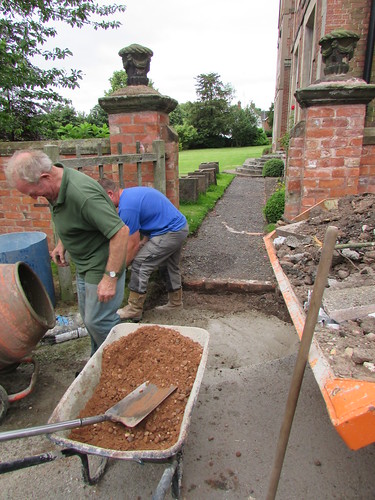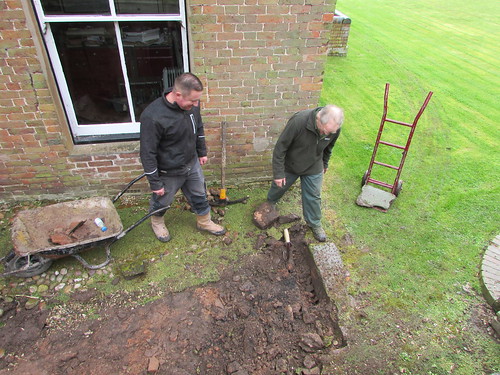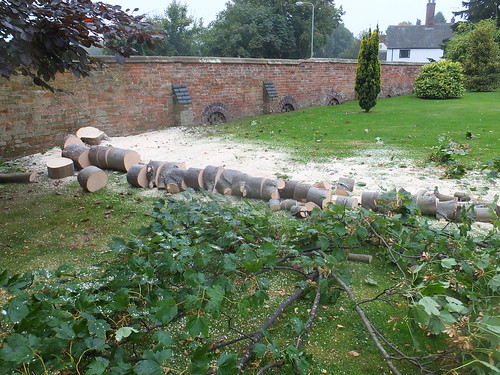skip to main |
skip to sidebar
One of the joys of property owning is the recurrent need for repairs. This is particularly the case with a building dating from 1640 which is also Listed Grade II. From time to time, I review some of the work carried out.
I think the first post describing external repairs covered 2014 and is here.
2016
Prior to the Garden Party at Brewood Hall in 2016 (described in the post here) repairs were carried out on the garden paths at the front of Brewood Hall. Work started with the delivery of materials by a large lorry equipped with a remotely-controlled self loading/unloading hydraulic crane.

Path repairs at Brewood Hall: OCL lorry (with a remotely-controlled self-loading/unloading hydraulic crane) delivering materials.
A couple of days later, a large skip was delivered to carry away spoil from the repairs.

Path repairs at Brewood Hall: Delivery of a large skip to carry away spoil.
The paths at the front of the building were relaid by Jim and Pete from A. M. Griffiths, together with Dave who has looked after the gardens (extending to about one acre) for some years.

Path repairs at Brewood Hall in 2016.
2017
During 2017, improvements were carried out to the path at the rear of the building where damaged stone slabs were replaced by reclaimed paviours to better match the paved area outside the kitchen and the small barn. Further work will eventually improve the adjacent decorative cobbled area.

Brewood Hall: Jim and Dave working on repairs to path at rear.
To gain access to the front elevation allowing repairs to the decorative cement quoins, a 'Genie' Self-Propelled Articulating Boom Z-45/25 was hired in. Whilst the machine was on site, some high-level repointing of brickwork was also carried out. It was an amazing machine and I took some pictures from an elevated position. The work was completed prior to the Brewood Garden Party in 2017 (described in the post here).

Repairs at Brewood Hall: 'Genie' Self-Propelled Articulating Boom Z-45/25
In November 2017 I visited Cawarden Brick and Tile Reclamation Yard near Rugeley with Brendan where we obtained sufficient reclaimed Staffordshire Blue Edgers for the front path which Dave later installed.

Cawarden Brick and Tile Reclamation Yard: Brendan inspecting reclaimed edgers.

Brewood Hall Garden 2018: Reclaimed edging installed adjacent to the front path.
Related posts on this website
Brewood Hall Maintenance.
Brewood Hall Tree Maintenance.
To see all my posts on Brewood Hall, select Label 'Brewood Hall' or click here.
My Pictures
Where necessary, clicking on an image above will display an 'uncropped' view or, alternately, pictures from may be selected, viewed or downloaded, in various sizes, from the album below:-
Repairs at Brewood Hall.
Reclamation Yard.
Brewood Hall garden has a number of trees. Just as the Hall itself, a Listed Building, requires maintenance the trees also require periodic inspection and attention. The situation is complicated because all the trees are within the Brewood Conservation Area.
In 2012 a group of oak trees along one boundary were pruned for the second time and this is described in the post here.

Oak Tree Pruning at Brewood
In September 2014, a self-set sycamore very near the front garden wall had to be felled. It had grown so as to threaten to demolish the garden wall. Although I'm not keen on sycamore, I'd given it a chance to grow clear of the wall but, of course. it didn't oblige. With a chain saw and an expert bit of rope work, Rik and Dave safely brought down the main trunk across the front lawn before quickly reducing the tree to a series of 'rounds'.

Sycamore felling at Brewood Hall, with Dave on the rope.

Sycamore felling at Brewood Hall: The felled tree reduced to a series of 'rounds'.
In contrast, I find silver birch attractive. My partner had planted one near the front gates in the 1980s as a replacement for a much older silver birch nearby which had been well-established when I came to Brewood in 1971 but had since died. The replacement tree lasted until 2017 when inspection showed that it was in danger of collapse so, reluctantly, I agreed to felling and Rik and Dave promptly carried out the work on 25th October 2017.

Tree felling at Brewood Hall: This view shows the height of the felled tree.
Related posts on this website
Oak Tree Pruning at Brewood Hall
My Pictures
Where necessary, clicking on an image above will display an 'uncropped' view or, alternately, pictures from may be selected, viewed or downloaded, in various sizes, from the album below:-
Oak Tree Pruning at Brewood.
Brewood Hall: Sycamore felling.
Felling of dying silver birch.
Even casual perusal of this blog is likely to reveal my enthusiasm for driving steam locomotives, latterly at a couple of preserved railways in the United Kingdom. At the Battlefield Line, I also drive the Diesel Multiple Units (DMU) owned by Ritchie Marcus and there's a steadily-increasing number of posts describing this (you can find them all here or by selecting 'DMU' from the list in 'Labels to select a blog topic').

DMU Days at the Battlefield Line: After taking the school party to Shenton on 4th July 2017, the 1-car coupled to the 2-car set wait at Shenton prior to the return to Shackerstone.
In the summer of 2018, these diesel railcars provide the 'Midweek Services' on Tuesdays, Wednesdays and Thursdays so I seem to be getting regular DMU driving turns. I've always enjoyed driving the 'British Railways Modernisation' DMUs, which I remember from my own childhood when they were first introduced but the afflictions of increasing age make a 'diesel day' increasingly attractive for a number of reasons.
Firstly, preparation time is much reduced, compared with steam. 'Checking levels', as on a car, is required but the laborious 'oiling round' is avoided. Whilst a visual examination around the underframe is essential, once the engines are started, also from ground level, the driver can return to the cab whilst the compressors establish sufficient control air pressure to allow movement.
Secondly, driving is carried out whilst seated. Whilst I don't find the seat design particularly good (and manoeuvring around it is tight), it represents luxury compared with most steam locomotives which either make no provision for sitting or offer a rather mean wooden tip-up seat. Gresley is renowned for fitting a padded leather bucket seat on some of his steam locomotives. On most designs, many drivers (the writer included) preferred to remain standing to make the most of the poor forward vision offered by the cab design.

Detail of the driver's adjustable seat.
I often say '90% of a driver's attention should be focussed on the line ahead'. We can debate the exact percentage but keeping a good lookout is vitally important. The windows across the full width of the DMU cab give a panoramic view down the line very welcome to steam drivers brought up on leaning out of the cab to get reasonable sightlines around the front of the boiler. Provided the blinds at the rear of the DMU cab are raised, the passengers, too, can enjoy the view of the route ahead. The blinds were provided, of course, for use at night when the lights in the passenger compartment would otherwise damage the driver's night vision. More modern designs of diesel railcar reverted to solid walls between passengers and cab.

DMU Days at the Battlefield Line: Driver's view leaving Market Bosworth for Shackerstone.
On a steam-hauled train, to give the driver any chance of watching the line ahead, it's a requirement that the locomotive is a the front of the train (except where special arrangements are made called 'push-pull' or 'auto' trains). This means that, at each and of the line, there's a period of furious activity where the locomotive is uncoupled from the coaches, shunted to the other end of the train and re-coupled. On DMU, a driving cab is provided at each end of the train so that, at the end of the line, it's only necessary for the driver to 'close' what had been the leading cab, move to the other end of the train and 'open' what had been the 'back cab' so as to become the leading cab. The business of 'closing' and 'opening' cabs involves the transfer of an electrical master key and removable handles to control the final drive and braking systems.
Although the supply of coal carried by a steam locomotive is normally arranged to suffice for a whole day, the water supply (which is boiled to produce steam, used to impel a piston up and down a cylinder producing useful work and then discharged as exhaust steam from the chimney) often requires replenishment a number of times a day. By contrast, a DMU may be able to run for a number of days before the diesel fuel tanks require topping-up and water (used to cool the diesel engines, as in a car) is recirculated.
 Refuelling the DMU at Shackerstone.
Refuelling the DMU at Shackerstone.
On a DMU, the driving controls, instruments and indications are laid out on the desk in front of the driver in a reasonably ergonomic manner unheard of on steam locomotives although Riddles, in designing the British Railways 'Standard' steam locomotives, attempted a convenient layout.

The driving controls, instruments and indications are neatly laid out on the desk in front of the driver.
Drivers also appreciated the 'power on demand' nature of the DMU. With steam traction, the power available to work the train depended upon many factors including time since last 'shopping', time since last boiler washout, quality of coal and, not least, attitude and competence of the fireman. In contrast, a DMU normally works as intended or doesn't work at all. That's a bit of a simplification but, in general, when a diesel driver opens the throttle, the power will flow, giving the driver a feeling of confidence that the job will go well.
But perhaps the best feature of working on a DMU is the opportunity to meet passengers. Many passengers seek out a seat in the leading coach where they can see the line ahead and watch the driver at work. In stations, passengers (men, ladies and children) can often be seen studying the cab and may ask questions. When working on steam, although we always try to acknowledge anyone nearby, the workload involved hinted at above means that a protracted chat is rarely possible. In contrast, when working on a DMU there are better opportunities for passengers to take photographs of the driver's 'office' or to answer questions (admittedly at the risk of boring them to tears - 'too much information'). I never cease to be amazed at the interesting backgrounds and experiences of our visitors. And, at the end of the day, I'm not quite as shattered (or dirty) as after a steam 'turn'.
















